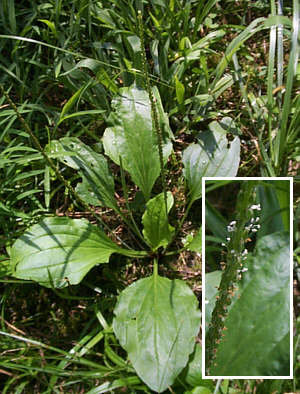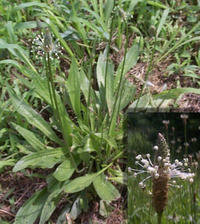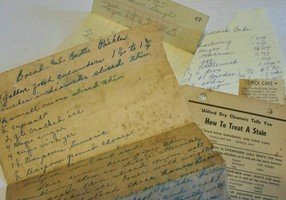





Of all the plants Aunt Bett and I gathered from the mountainside, Plantago was her favorite. It would cure most anything, she said. I didn't think it had much going for it as far as looks were concerned, except it came in two different sizes, fat and skinny. She called the fat one Broadleaf; the skinny one was Snakeweed. I made sure I wore my asphidity bag when we gathered the Snakeweed.
"Good night, sleep tight, don't let the bedbugs bite!" I have no idea who said that, and have no inclination to research the words, but I use them because that is as close as I ever came to a bedbug. My dear Aunt Bett thought bedbugs were surely alien creatures out to get us. She believed the same thing about head lice (and I almost agree with her because the mere mention of either creature makes my skin crawl).
Being a Mountain Medicine Woman, Aunt Bett had a big responsibility. It was not easy to get to the doctor during the middle part of the twentieth century, even the houses were few and far between. There was very little money available at that time. WWII had taken many lives, most of them male, and women in particular were struggling to make a living for their families by the grit of their teeth and whatever they could pull from the mountain that would sustain them. And those widows did not know how to drive; the fact is they could never have afforded a car. When there was a medical crisis within a family, many times the family would show up on the doorstep of a Medicine Woman, carrying with them some manner of payment. It might have been a chicken, a dozen eggs, whatever they had, they would give for relief from whatever ailed them. And if they had nothing to give, they were never turned away.
Really, I am not digressing, but a good story teller sets the scene, and I want you to see in your mind entire families seated on Aunt Bett's front porch waiting for treatment for seriously infected skin eruptions. "Bedbugs", she proclaimed, loud and clear, "y'all got bedbugs! Run pick us some broadleaf, girl, and chew it on the way!"
Broadleaf Plantain was the common name of one of two plants that were very nearly identical in their medicinal properties: Plantago lanceolata and Plantago major. The first has a very narrow leaf and a tall stalk which is topped with an almost invisible tiny white flower. It is also known as Snakeweed Plantain. The second has a broad leaf, a tall stalk and on the stalk are hundreds of tiny purple flowers and seed pods. It is the more palatable of the two, and its young leaves were often used in salads. For bugbites it was the broad leaf I was sent to pick, thank goodness, because the narrowleaf tasted about like the asphidity bag smelled.
It wasn't that the tiny bed bugs did much damage, They didn't, but they bit, then the bite itched and itching produced scratching and scratching with dirty fingers often created an infection. Broadleaf was chewed, placed on the cleaned bugbite, and wrapped and tied with a clean white cloth to hold in place. Within a day or two the infection was all cleared and the problem was solved. She told them they could also boil the leaves before putting them on the bug bite, but this being summer there was no fire in her kitchen stove. The fastest thing to do for the infected bites was to clean them and patch them up with the munched juicy warm leaves. Yuck!!! Eventually she taught most of the folks to find their own broadleaf and cure their own bedbug bites, hoping all the while they could completely eradicate the intrusive little bedbugs.
Now, though aggravating, bedbugs really cause no damage. They are a small nocturnal insect that lives by hemalophagy, which means that it feeds on the blood of warm blooded hosts. They are attracted by exhaled carbon dioxide and body heat, not by dirt, and they feed on blood, not waste. Bedbugs pass no known disease from one host to another. The problem is getting rid of them. Aunt Bett's broadleaf could cure the infected bite, but it was up to the family to wash every piece of bedding, sleeping garments and most everything else in the bedroom in very hot water. She also advocated scrubbing floors and rugs as well.
I have mentioned that Aunt Bett believed that every living thing had a purpose, and that included plants. The two Plantagos had their purposes as well. I was never told the purpose of the bedbugs.
Aunt Bett knew of many uses for Plantago. It is a perennial herb and is fairly well naturalized throughout the world, a very adaptable plant. She told me that it dated back to ancient times, and our Native American friends carried the dried and powdered root around with them as a cure for snakebite. She said they called the plant "life medicine" and I think she believed that as well. As a food the young leaves of the broadleaf could be used in salads, and cooked as greens. As an infusion, the tea was used to ease asthma and other bronchial and lung infections, as well as dysentery, and other problems with the digestive system. The root of course is an anti venom for snake bites, used on humans as well as work animals and pets. The root swells in the gut and acts as a laxative. The seeds can be used to rid a body of worms, and mixed with water, any part of the plant is a soothing eye lotion. Only recently I have learned that ingestion of plantain causes a natural aversion to tobacco and is currently being used in stop smoking preparations. (www.altnature.com)
According to other sources (www.botanical.com) plantain entered into almost every old remedy, often boiled in combination with other plants and flowers. So perhaps it was a real "life medicine."
Both types of plantain grew wild and all over the place in the mountains, we really didn't have to go far to find it, as long as it was not in the direct path of humanity. Aunt Bett thought it much cleaner and more effective if it were gathered far off the beaten path. She always told me it was healthier if humans and domesticated animals had not touched it. I am not sure what she considered my dogs to be since at least one of them followed us wherever we went; but truthfully Pepper did not really stay near us, she was off chasing squirrels and rabbits and only came when I called to her.
Digging deeply into my memory I can remember that Aunt Bett used broadleaf plantain first as a quick remedy straight off the plant for bed bug bites as well as other insect bites, but of course it had to be chewed first. She also made it into a tea, and from her writings here is her tea recipe:
For colds and flu:
1 tabls dry or fresh whole plantain, root, seeds and leaves
add to 1 cup of biling (boiling) water, let set for 10 mins, then strain and sweeten with honey. Drink from cup through the rest of the day till empty.
She also made a plantain salve:
Chop whole clean plant, roots and all.
Add a cup of lard. (Oh my, lard! But this was a salve, not to be eaten.)
Cover and cook down slowlike till soft like mush.
Strain while hot.
Pour into small jars or salve tins while still warm enough to pour.
Use for bites, pison ivy, burns, sores.
Decoctions were made as well, often mixed with other herbs and flowers to store to be used during the winter months. Please refer to previous Aunt Bett articles for decoction recipes which included boiling two or even three times to get the most medicine from the plant.
Plantago was easily found across the creek and on the lowest part of the hillside in the back of her house. Of course it grew all over her yard too, but we could not gather leaves too near where people walked. In the fall we gathered it to be dried. Seeds were separated and saved separately as were the leaves and roots. For some medicines she used only one of the three ingredients, and for others she combined the three.
I find in her papers no separation of the two plants, she used them interchangeably. In my own research, I find that to be true as well, so I have written this article with that in mind. There is one thought that I have and that is this: Native Americans called the narrow leafed Plantago "snakeweed". I would suppose that particular plant was the specific one used on a snakebite. I also noticed that she cooked the snakeweed for eating, but she never used it in a salad or for her medicinal chewing. Thank goodness. It would have been similar to eating my asphidity bag.
My thanks go to Weezigreens of Seward, Alaska whose photo I used as a thumbnail appeared in Plant Files.
And my deepest appreciation goes to Daniel Reed whose photos of Plantago appear on his website, www.2bnthewild.com and who was very generous with his permission for their use.
The photo of remnants of Aunt Bett writings belongs to the author. Believe me, new spectacles (Aunt Bett's word) are in order!

Copyright © www.100flowers.win Botanic Garden All Rights Reserved